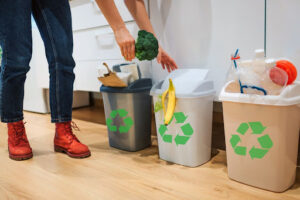Every family is responsible for efficiently recycling their household waste, since doing so helps save natural resources, lower trash mass, and minimise our environmental footprint. Still, negotiating the complexity of what may be recycled and how can frequently seem difficult and overpowering. A definite plan is crucial, from learning about council-collected supplies to safely removing more house project garbage. This guide tries to clarify the process and equip families with useful information to confidently and effectively recycle more. Handling bigger volumes of waste correctly is also essential for those having home clearances or upgrades; therefore, using a small skip hire service can be beneficial. Handling nonrecyclable trash calls for an environmentally friendly and effective solution.
Be thoroughly conversant with the guidelines of your local council.
Understanding and following the particular rules of your local council is the most crucial first move for successful recycling. Regarding what materials they accept in kerbside collections and how they should be presented, rules differ greatly between different authorities. Some might tolerate plastic buckets but not films or a particular card type, but not others. Get acquainted with their waste area on their official website, which offers thorough lists of permissible items. Careful sorting following local regulations is the foundation of effective household recycling since contamination from improper items can cause whole truckloads of recycling to be dumped.
Master the Fundamentals, Sorting Common Materials
Effective home recycling begins with a basic sorting system. The main materials most councils gather are: Newspapers, magazines, cardboard boxes (flattened), and food containers, which comprise paper and cardboard. Get rid of polystyrene inserts and plastic containers.
Usually, trays, pots, tubs, and bottles are made of plastic. Since they change, always check the resin code and council guidelines.
Glass: Bottles and jars. Usually gathered apart because of weight.
Metals: aluminium foil, empty aerosols, food and beverage containers.
Preventing contamination requires rinsing of containers to eliminate food remains.
Compostable organic waste created at home.
Home garbage is mostly organic material, including coffee grounds, garden trimmings, fruit leftovers, and vegetable peels. Composting this trash at home is among the most effective recycling projects a household can do. It reduces the general volume of garbage, creates a nutrient-rich soil conditioner for your garden, and reduces the environmental expense of waste collection and treatment. Gather leftovers and take them to a compost bin or heap outside using a countertop caddy to turn kitchen trash into a useful resource.
Reducing and Reusing
Families should give Reduce and Reuse priority before even considering recycling. By deliberately reducing consumption through choosing things with little packaging and avoiding single-use items, the most effective way to reduce waste is by Reusing is finding new applications for already available products, including donating unwanted items to charity stores, turning vintage apparel into cleaning rags, or using glass jars for storage. Originally preventing waste formation, these habits are far more environmentally friendly than after-the-fact treatment.
Handling hazardous and electrical waste
Because of their poisonous or hazardous ingredients, some things should never be dumped in recycling bins or ordinary trash. This includes paint cans, chemicals, discarded electrical equipment (WEEE waste), batteries, and energy-saving lightbulbs. Handle these chemicals with particular caution; for safe disposal, bring them to your local household garbage recycling plant (HWRC). Many retailers also provide takeback programs for electronic products and batteries. Proper disposal helps to reclaim priceless elements and prevents hazardous substances from contaminating the planet.
Give and upcycle before you throw anything out.
For products no longer needed but still in decent condition, recycling ought to be the final option. Consider if anything can be given a second life before being discarded. Usually offered to charity stores, sold online, or given away via local organisations, garments, furniture, books, and toys can be donated. Upcycling, that is, artistically repurposing an old object into something fresh and practical, is another excellent approach to cut down on garbage. This approach lengthens product lifetime, lessens demand for new resources, and encourages a circular economy.
Controlling Bigger Projects using a Small Skip
The amount of garbage produced for major household clearances, garden landscaping, or renovation projects can be enormous. For these circumstances, a little skip hire is the perfect answer. Mixed trash not gathered by the council, like soil, rubble, and nonrecyclable building materials, these skips are ideal. Respected skip hire businesses will separate the garbage at a specialised facility, to avoid as much as possible from landfill. To guarantee the appropriate skip is given and that disposal rules are obeyed, always let the business know the kinds of trash.
Conclusion
For every household to help conserve the environment, home waste recycling is a simple yet effective means. Families can significantly reduce their contribution to trash by adhering adept local rules, using appropriate cleaning supplies, and giving reuse and reduction top priority. Composting organic waste and proper disposal of hazardous materials help this effort even more. Using a tiny skip hire guarantees responsible bulk waste management for bigger projects. Ultimately, an informed and proactive attitude to waste turns a regular chore into a meaningful activity, guaranteeing valuable materials are recovered and reused, therefore paving the route toward a more sustainable future for everyone.


